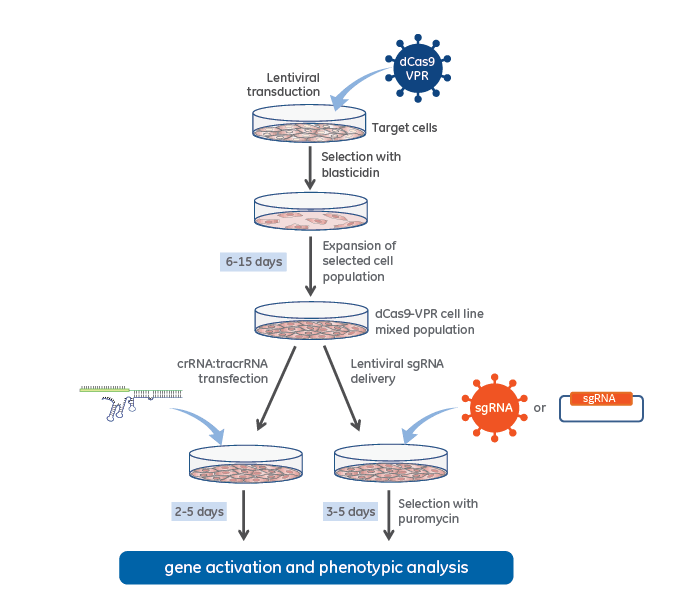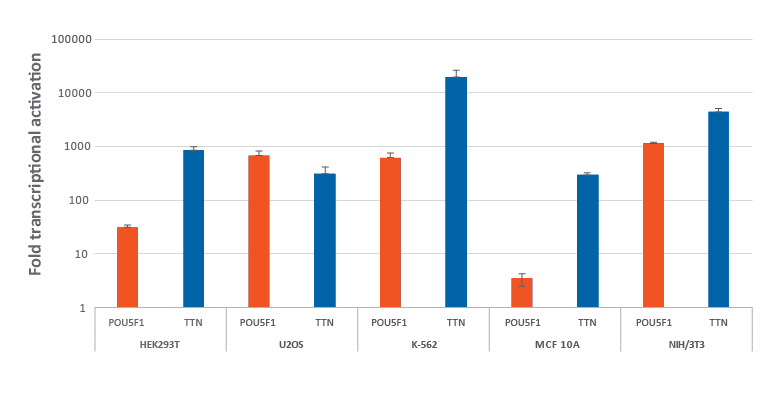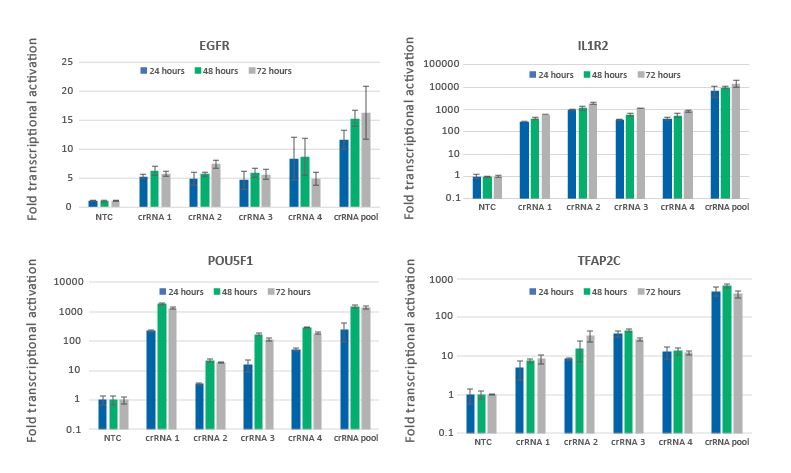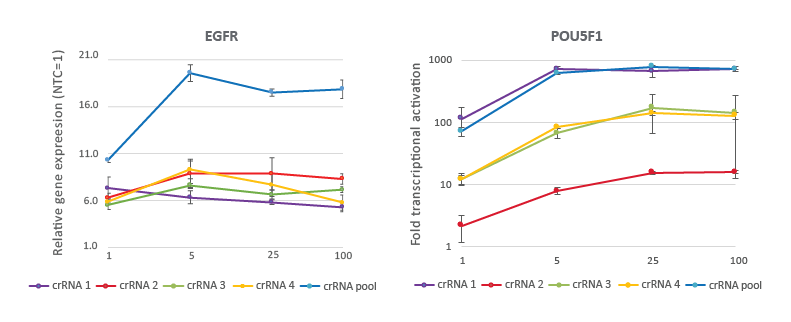- CRISPR activation reagents
- CRISPRa synthetic crRNA positive controls
CRISPRmod CRISPRa synthetic crRNA positive controls
Validated synthetic crRNA pool or individual for experimental optimization of transcription activation experiments

The CRISPRa positive controls will selectively activate a well characterized human or mouse gene. Positive controls are recommended for optimization and ongoing monitoring of delivery conditions and dCas9-VPR expression prior to experiments with target gene-specific guide RNAs.
The level of activation achieved will depend on your cell type and basal level of expression. Normalization of the activation level to a non-targeting control will provide a baseline for determining optimal dCas9-VPR expression, transfection efficiency, and timepoint for your assay.
Highlights
- Choose from human or mouse Titin (TTN) or POU class 5 homeobox 1 (POU5F1).
- Use to determine optimal experimental conditions for efficient gene activation.
Please note that tracrRNA is required for use with CRISPRa synthetic crRNA reagents.
| crRNA nmol | tracrRNA nmol | 96-well plate 100 µL volume | 24-well plate 500 µL volume | 12-well plate 1000 µL volume | 6-well plate 2500 µL volume |
|---|---|---|---|---|---|
| 2 | 2 | 800 | 160 | 80 | 32 |
| 5 | 5 | 2000 | 400 | 200 | 80 |
| 10 | 10 | 4000 | 800 | 400 | 160 |
| 20 | 20 | 8000 | 1600 | 800 | 300 |
CRISPRa workflow diagram with stable dCas9-VPR expression

CRISPR activation workflow with lentiviral dCas9-VPR and synthetic crRNA:tracrRNA (left side) or Lentiviral expressed sgRNA (right side).
Efficient gene activation with CRISPRa synthetic crRNA in multiple dCas9-VPR stable cell lines

HEK293T, U2OS, MCF 10A, NIH/3T3 stably expressing integrated CRISPRa dCas9-VPR were plated at 10,000 cells/well and transfected using DharmaFECT Transfection Reagents with CRISPRa synthetic crRNA:tracrRNA (25 nM) targeting POU5F1 and TTN. K562 cells were electroporated with CRISPRa synthetic crRNA:tracrRNA (400 nM) targeting POU5F1 and TTN. Cells were harvested 72 hours post-transfection and the relative gene expression was measured using RT-qPCR. The relative fold transcriptional activation for each gene was calculated with the Cq method using GAPDH as the housekeeping gene and normalized to a non-targeting control.
CRISPRa gene activation fold depends on the endogenous gene expression level

Genes with low or no basal expression are easier to activate to a robust level, while genes already expressed at high level are more difficult to further over-express. U2OS-dCas9-VPR stable cells were plated at 10,000 cells/well and transfected using DharmaFECT 4 Transfection Reagent with CRISPRa synthetic crRNA:tracrRNA pools (25 nM) targeting 23 genes with different basal level of expression. Cells were harvested 72 hours post-transfection and the relative gene expression was measured using RT-qPCR. The CRISPRa-mediated fold transcriptional activation is shown in the upper graph where the genes are ordered from low to high level of basal transcript expression in samples treated with NTC control and is shown in the lower graph as basal target gene expression (compared to GAPDH control).
CRISPRa gene activation is observed at 24 hours and peaks at 48-72 hours

U2OS-dCas9-VPR stable cells were plated at 10,000 cells/well and transfected using DharmaFECT 4 Transfection Reagent with CRISPRa synthetic crRNA:tracrRNA targeting EGFR, IL1R2, POU5F1 or TFAP2C. Four CRISPRa crRNAs were used either individually or pooled (to a total concentration of 25 nM). Cells were harvested at 24, 48, and 72 hours post-transfection and the relative gene expression was measured using RT-qPCR. The relative expression of each gene was calculated with the Cq method using GAPDH as the housekeeping gene and normalized to a non-targeting control.
CRISPRa dose curve demonstrates highly effective gene activation at 25 nM working concentration

U2OS-dCas9-VPR stable cells were plated at 10,000 cells/well and transfected using DharmaFECT 4 Transfection Reagent with CRISPRa synthetic crRNA:tracrRNA targeting EGFR or POU5F1. The pre-designed crRNAs were used either individually or pooled at four concentrations (1, 5, 25, 100 nM). Cells were harvested 72 hours post-transfection and the relative gene expression was calculated using RT-qPCR. The relative expression of each gene was calculated with the Cq method using GAPDH as the housekeeping gene and normalized to a non-targeting control.
Application notes
Safety data sheets
Related Products
Purified lentiviral particles or plasmid DNA for generation of stable dCas9-VPR nuclease-expressing cell populations
Non-targeting controls to evaluate baseline cellular responses to CRISPRa components in the absence of gene target-specific crRNA.
Chemically synthesized trans-activating CRISPR RNA required for use with synthetic crRNA for fast and easy gene editing
Predesigned synthetic guide RNA for over-expression of human and mouse genes using CRISPR activation. Just search for your gene! Available as pooled or individual reagents.
